Rynus stands unique from other decentralized platforms on the market and offers superior services for all.
Rynus offers a range of unique features that distinguish us from other decentralized networks in the market.
Comprehensive Services
Rynus is a Decentralized Network for AI Training, Data Labeling, and 3D Rendering fields, combining the strengths of other competitors into a single, unified platform.
Furthermore, our vision extends beyond this. AI/ML and 3D rendering are just the beginning. In the future, we aspire to integrate everything into our DePIN platform, such as storage, gaming, automobile, metaverse, and more.
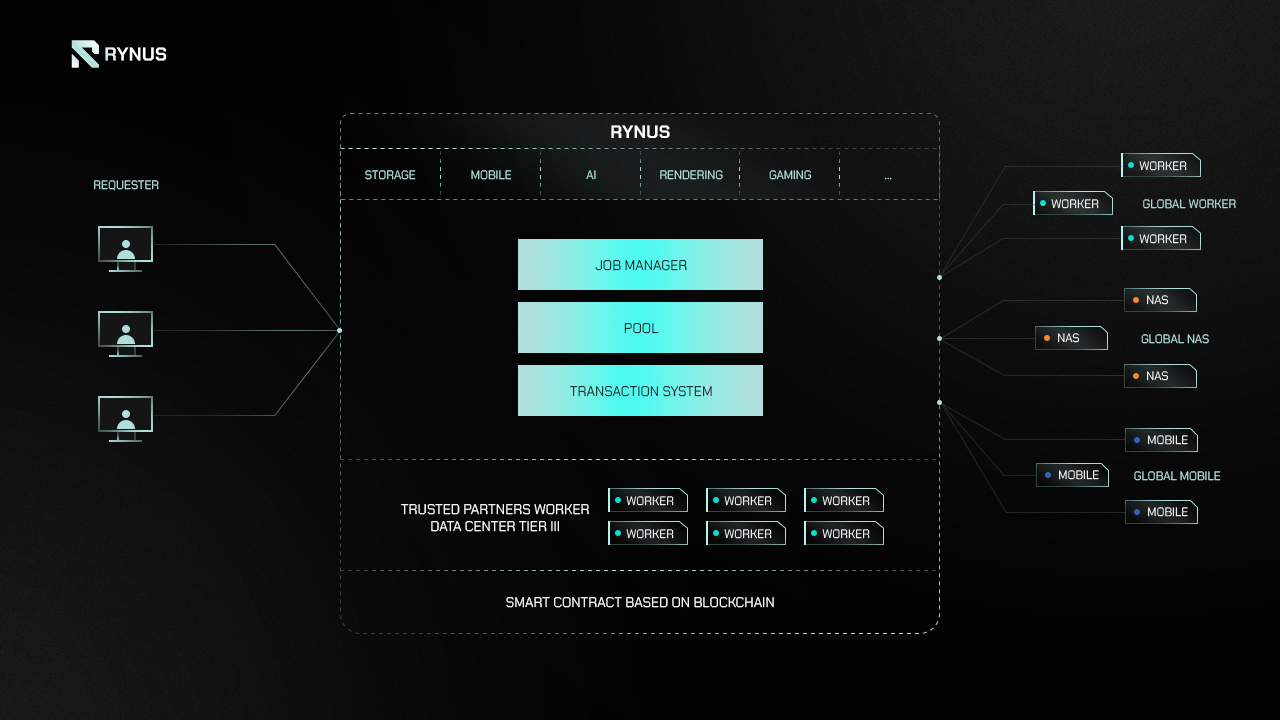
Rynus Comprehensive Services in Vision
First-Ever On-Chain Data Labeling
Rynus introduces the first-ever on-chain data labeling solution, transforming the traditional data labeling process by enhancing transparency, security, and accessibility. This enables Rynus to offer a decentralized and efficient platform for data preparation – the first step in the AI/Machine Learning Pipeline.
- Multiple Labeling Services: Rynus supports a wide range of data labeling tasks, including Image Labeling, Text Labeling, Audio Labeling, and Video Labeling. This allows AI/ML developers to prepare data across multiple formats, ensuring high-quality inputs for various machine learning applications.
- Cross-Device Labeling Workforce: To make data labeling accessible and scalable, Rynus leverages a decentralized workforce that can label data from any device—mobile phones, tablets, PCs, and laptops—maximizing participation and ensuring flexibility for Workers. This flexibility expands the workforce pool, allowing Rynus to handle large-scale data labeling projects with ease.
- Convenient Access via Telegram Mini App: Rynus uses a Telegram Mini App to manage and distribute labeling tasks, making it easy for Workers to engage with the platform from any location. With Telegram Mini App, labeling tasks are accessible, streamlined, and completed efficiently, with Workers participating through simple tap-to-earn or listen-to-earn activities.

ZKP and State Compression
Rynus leverages Zero-Knowledge Proof (ZKP) and State Compression technologies to address the challenges of managing and storing vast amounts of data in decentralized network for AI Data Labeling, AI Model Training, and 3D Rendering. These are key to minimizing on-chain storage costs while maintaining security, transparency, and efficiency.
Big Data Challenge

Rynus network handles massive datasets and coordinates millions of decentralized Workers globally:
- Data Labeling: A single job may include millions of images requiring accurate annotation.
- AI Model Training: Training a computer vision model can require datasets of over 1,000,000 images.
- 3D Rendering: Rendering a 90-minute movie at 24 frames per second involves processing 129,600 frames.
With each image, item, frame, and Worker signals and information that need to be recorded, the challenge lies in storing these proofs on-chain without incurring prohibitively high fees.
State Compression
Rynus applies State Compression to drastically reduce on-chain storage costs. State compression uses “tree” structures to cryptographically hash off-chain data, in a deterministic way, into a single final root hash, which is then stored on-chain. The root hash acts as a verifiable proof for all data within the tree, enabling Rynus to cryptographically verify off-chain data without storing the full dataset on-chain.
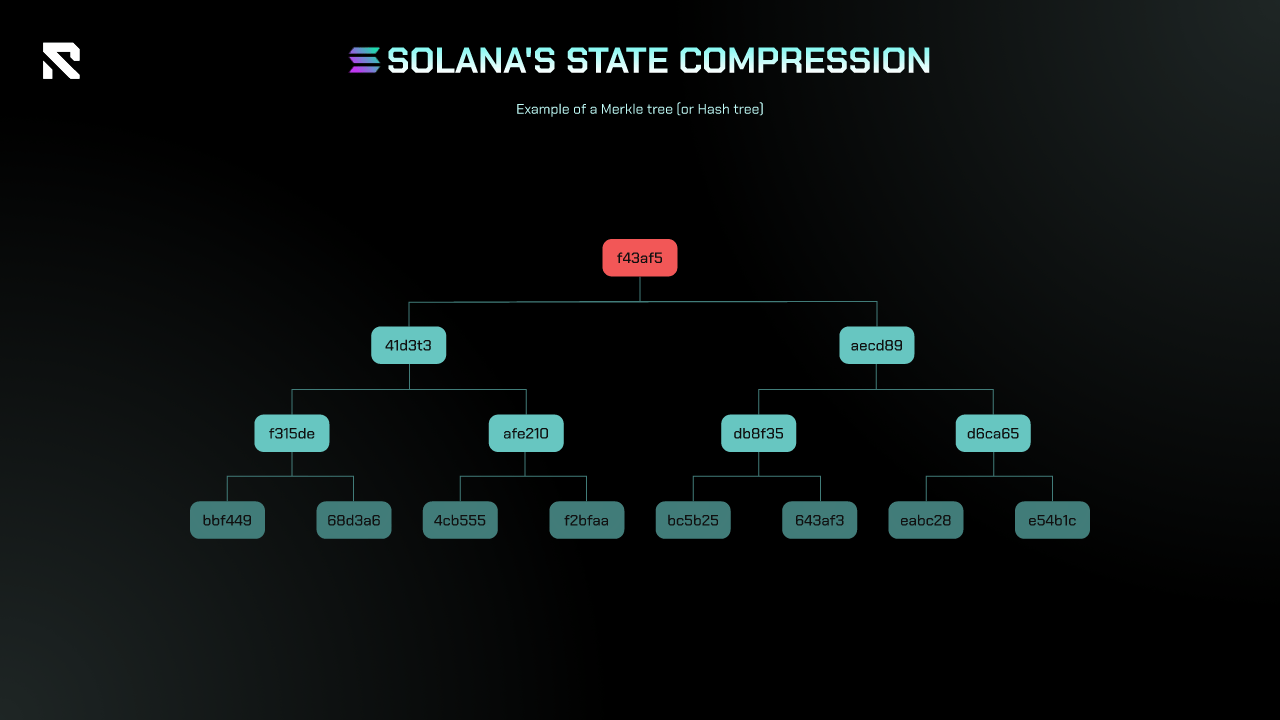
Benefits: This method reduces the size of on-chain storage while maintaining the integrity and verifiability of the data. Therefore, significantly lowers the costs associated with storing and proving large datasets, enabling scalable solutions for big data tasks.
Zero-Knowledge Proof
Rynus integrates Zero-Knowledge Proof technology, particularly in its Data Labeling service, to ensure secure data processing and reliable consensus mechanisms.
ZK Proof enables Rynus to process data securely without disclosing sensitive details. For example, in Data Labeling, an image is sent to multiple annotators. If 51% of consensus annotators with high credit scores provide the same label, it is considered the correct result.
Benefits:
- Guarantees data security and privacy by avoiding unnecessary disclosure of details.
- Ensures labeling accuracy through a decentralized consensus mechanism while reducing vulnerabilities.
By combining State Compression for cost-efficient on-chain storage and Zero-Knowledge Proof for secure data processing, Rynus delivers a scalable, decentralized solution for big data tasks like Data Labeling, AI Training, and 3D Rendering.
Big Data Transfer
The seamless transfer of big data poses a critical challenge for any decentralized and centralized systems. Particularly in today’s landscape, big data plays an increasingly vital role in AI training and machine learning. The quantity and quality of data directly impact the learning and pattern recognition capabilities of AI systems.
With the rapid advancement of technology, AI models have evolved significantly, resulting in minimal differences among them. In some cases, even tools like ChatGPT can assist in creating a training model. Consequently, the quality of input data is now the critical factor in determining training outcomes. Training involves a model learning from data—the more data available, the more the model can learn, leading to greater accuracy. This underscores the critical importance of big data in AI. Efficient big data transfer is essential and foundational for any AI training service.
When utilizing a third-party AI training service or platform instead of training locally, an excellent data transfer tool becomes indispensable. Without the capability to transfer data effectively, neither the service/platform nor the AI model will function properly. Big data transfer is a significant concern for all cloud computing service providers, each employing various tools and protocols for file transfer.
At Rynus, we have developed our proprietary protocol with six standout features to address the complexities of big data transfer. Rynus has also introduced its own desktop app as a specialized data transfer tool, designed to offer superior performance compared to other available tools.
1. File Splitting
Rynus Network intelligently determines the optimal segmentation of files based on the client’s network conditions. For instance, for a 1 GB file, Rynus may initially divide it into smaller, more manageable parts of 100 KB. As the client’s network improves, Rynus adjusts dynamically, potentially dividing the file into larger segments, such as 300 KB.
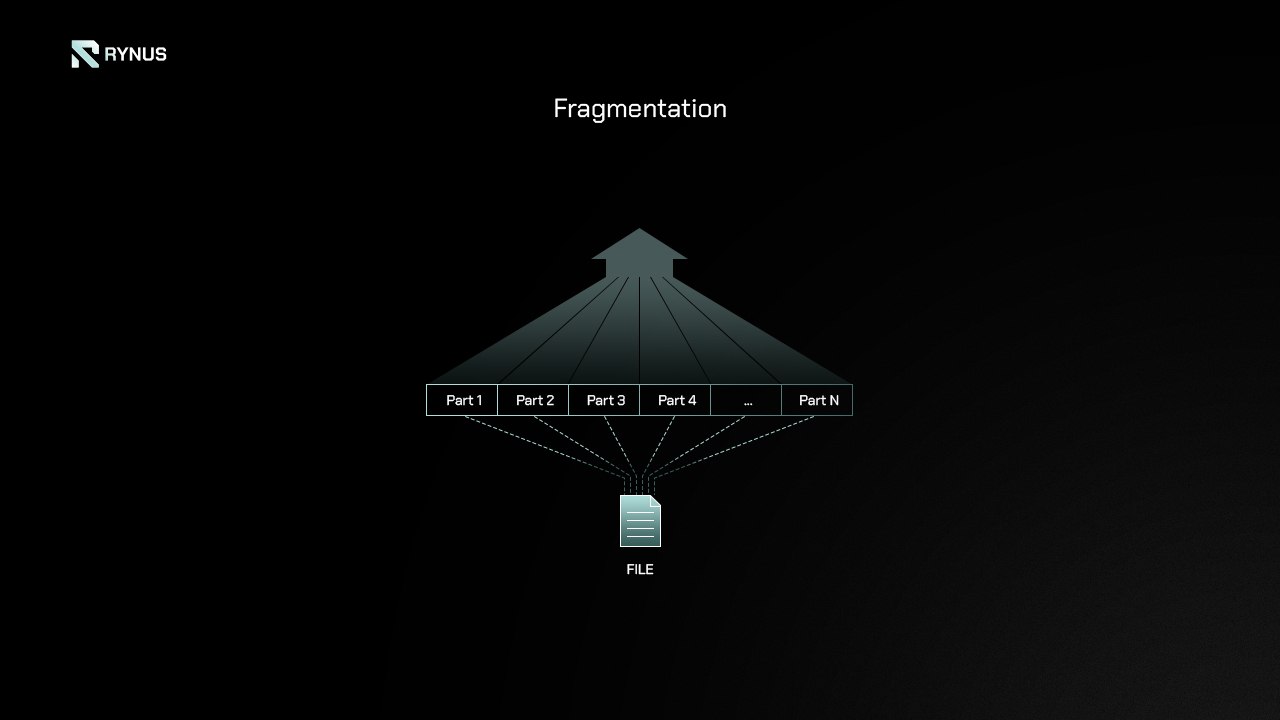
Another reason behind this feature is to maximize bandwidth usage efficiently. Whether the available bandwidth is high or low, Rynus ensures that file segments are transferred using the full bandwidth capacity.

2. File Compressing
Uploading a folder with 1000 files totaling 1 GB can be time-consuming compared to a single 1 GB file. Hence, Rynus employs compression techniques aligned with our standards. This process compresses the files before segmenting and transferring them, ensuring fast upload speeds.
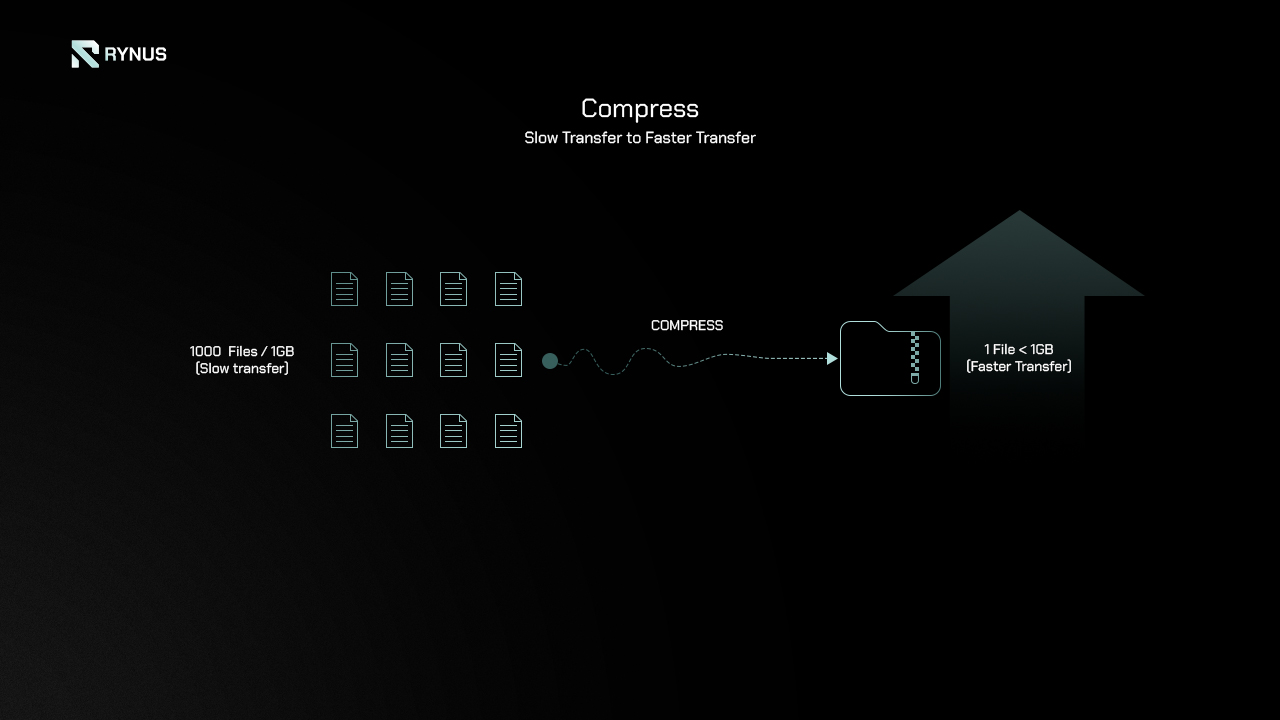
3. Pause/Resume Functionality
Consider a case where a client has uploaded 80% of 1 TB data but encounters a network interruption. Upon reconnection, the client does not need to restart the upload from scratch. Instead, they can seamlessly resume from the point of interruption, uploading only the remaining 20%. Additionally, users can pause and resume uploads at their convenience, facilitated by Rynus’s file numbering system that tracks and manages pieces of uploaded files.
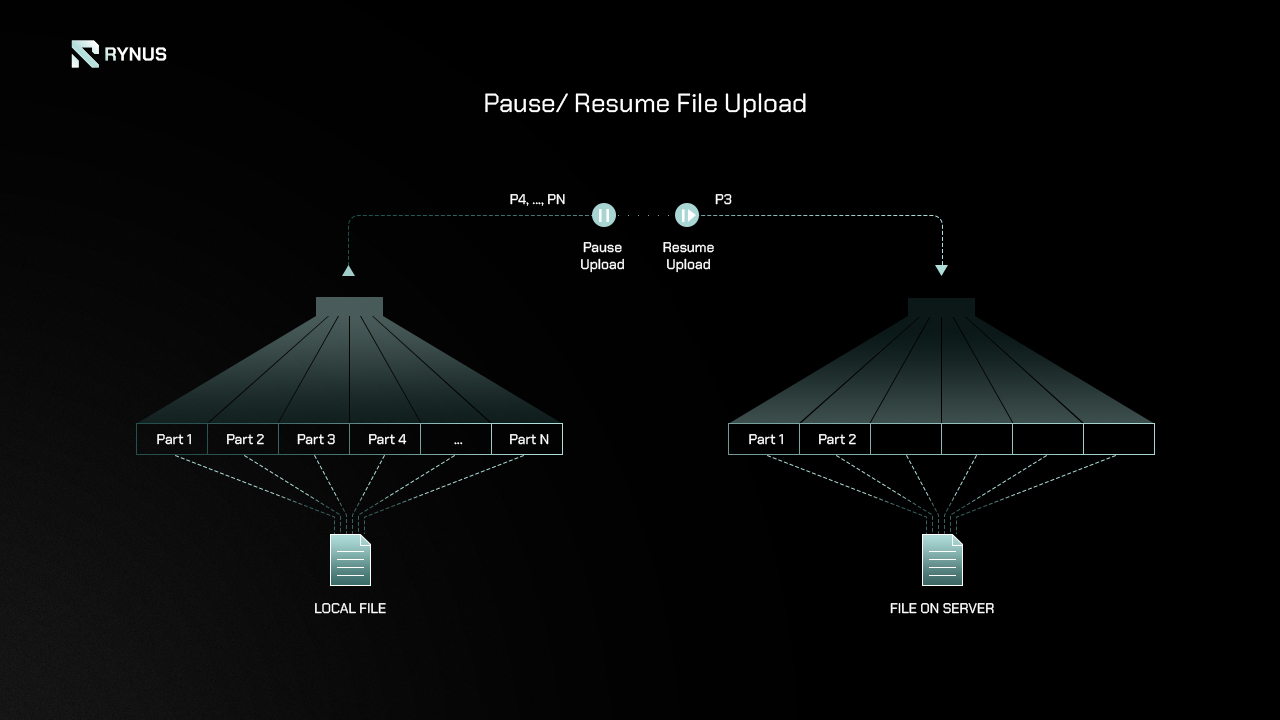

4. Selective File Upload
Modifications may be necessary during the course of project work. Rather than re-uploading an entire folder containing numerous files, Rynus identifies and uploads only the files that have been updated. This efficient approach avoids redundant uploads of unchanged files.
These four points allow Rynus’s solution to adapt dynamically to varying network conditions and ensure efficient file transfers. Furthermore, to optimize the process and minimize time, Rynus leverages the following approach.
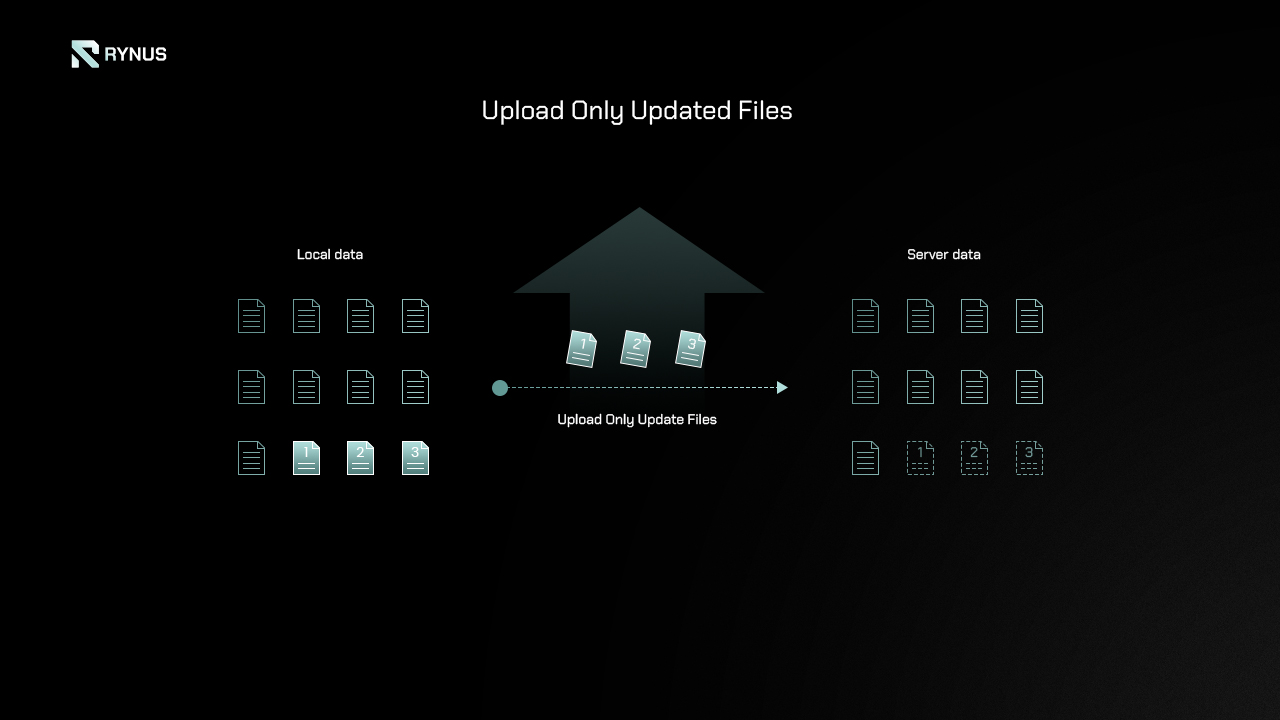
5. Optimal File Routes
When transferring client data, Rynus does not rely on a single path from A to B. Instead, we explore multiple routes through different network nodes. Rynus tests various routes by sending “seed files” – small, 1 KB pieces through each route. The route with the fastest response time is then selected, ensuring fast and efficient file transfers.
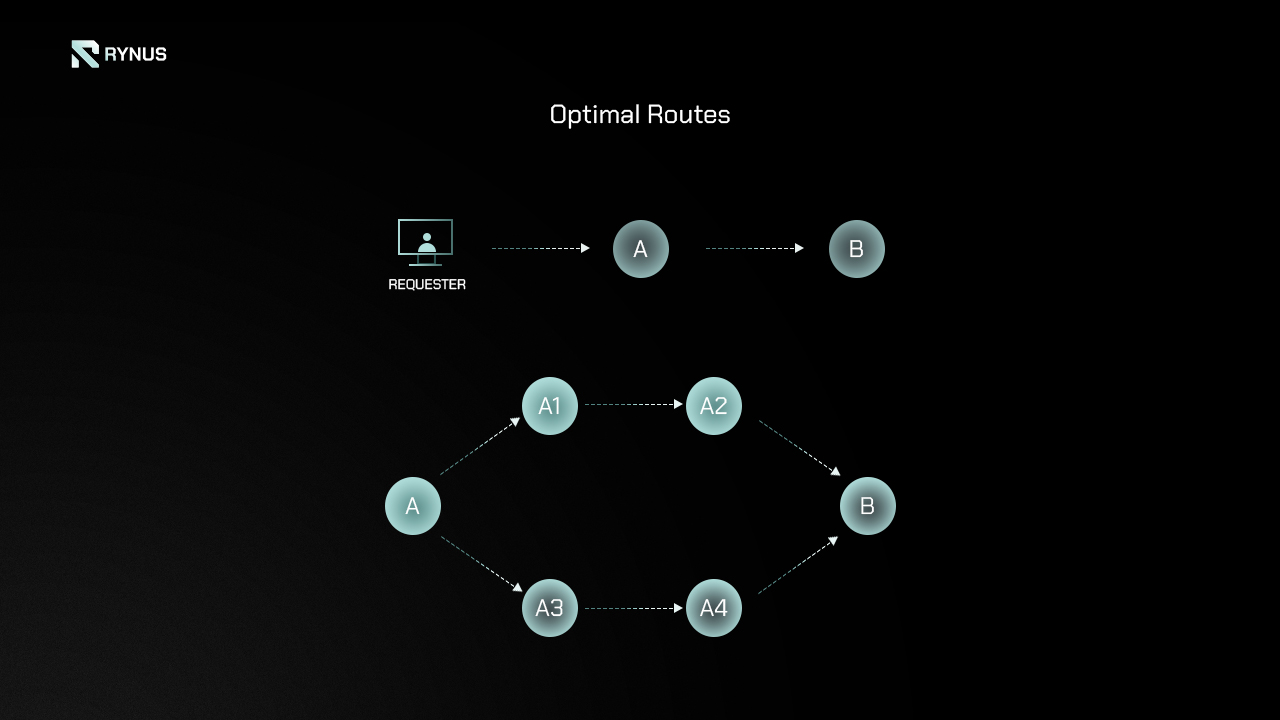
6. Peer-to-peer Transfer
Rynus also develops a Peer-to-peer (P2P) file transfer between Workers, allowing transferring files directly between multiple Workers in the Rynus network. The nodes can communicate and exchange data directly, efficiently utilizing network resources to speed up the file transfer process.

Extensive Experience and Case Studies
Rynus did not embark on building our decentralized network from scratch. We bring over five years of experience in delivering centralized products and services, having successfully handled millions of 3D rendering and AI training jobs for clients. Additionally, we have comprehensive case studies and pipelines for specific AI training and 3D rendering cases.
Tier III Data Center
Rynus operates its own Data Center that meets Uptime Institute’s Tier III Standards as well as others such as Operation, Quality Management Standards, Information Security Standards, and Energy Management Standards. Our Local Workers ensure uninterrupted service even before Global Workers join the network.
Platform Compatibility
The current AI training and 3D rendering market is fragmented, with each enterprise and individual having their own pipelines and preferred platforms. Rynus supports all AI platforms and 3D rendering platforms.
For AI, users can build, train, and tune AI, Machine Learning, and Deep Learning models with any AI software like TensorFlow, Jupyter, Anaconda, Python, PyTorch, MXNet, Keras, CNTK, Caffe, and others.
For 3D rendering, users can render with any 3D software, render engines, and plugins, including both real-time rendering (Lumion, Unreal Engine, Twinmotion, Enscape, Chaos Vantage, D5 Render, etc.) and offline rendering (Redshift, OctaneRender, Arnold, V-Ray, iRay, KeyShot, RenderMan, etc.).
GPU Diversity
Rynus supports all types of GPUs from different manufacturers including NVIDIA, AMD, Apple, and Intel. We plan to develop a multi-GPU rendering engine and a plugin for TensorFlow that works with both NVIDIA and AMD GPUs.
Privacy and Security
Rynus adopts new security technologies and ensures the data security of our users with multiple layers of protection.
1. Data Center Tier III
Rynus Data Center Tier III includes both physical security and data security.
- Physical Security: Our Tier III data centers incorporate robust security features such as fences, gates, and security cameras to protect the facility. Additionally, these data centers are strategically located in safe regions to mitigate the risk of natural disasters. The infrastructure is specifically designed to endure events like earthquakes, floods, and fires, ensuring uninterrupted service.
- Data Security: To safeguard consumer data, our Tier III data centers deploy advanced security mechanisms including encryption, firewalls, and intrusion detection systems. These measures are crucial in preventing unauthorized access and ensuring the integrity and confidentiality of sensitive information.
2. Two-Factor Authentication
Two-factor authentication is integrated when logging in to the Rynus Cloud and Transfer application.
3. Secure Sockets Layer (SSL)
SSL certificates are integrated into the Rynus Cloud, REST APIs, and backend services.
4. Secure File Transfer Protocol (SFTP)
Files are transferred to Rynus’s centralized server using the Transfer application via SFTP.
5. Server-Side and Client-Side Encryption
Server-side and Client-side encryption is integrated into REST APIs to encrypt data being transmitted.
6. AES and RSA Encryption
AES and RSA encryption algorithms are applied across the entire system, including end-user apps and backend services.
7. End-to-End Encryption (E2EE)
End-to-end encryption is integrated into the Worker application and backend Worker manager.
Profit-Optimized Workers
Rynus GPU Workers are optimized for profit, combining AI model training, 3D rendering tasks, and coin mining. The Workers seamlessly switch to mining coins during idle time when not receiving AI or 3D rendering jobs.
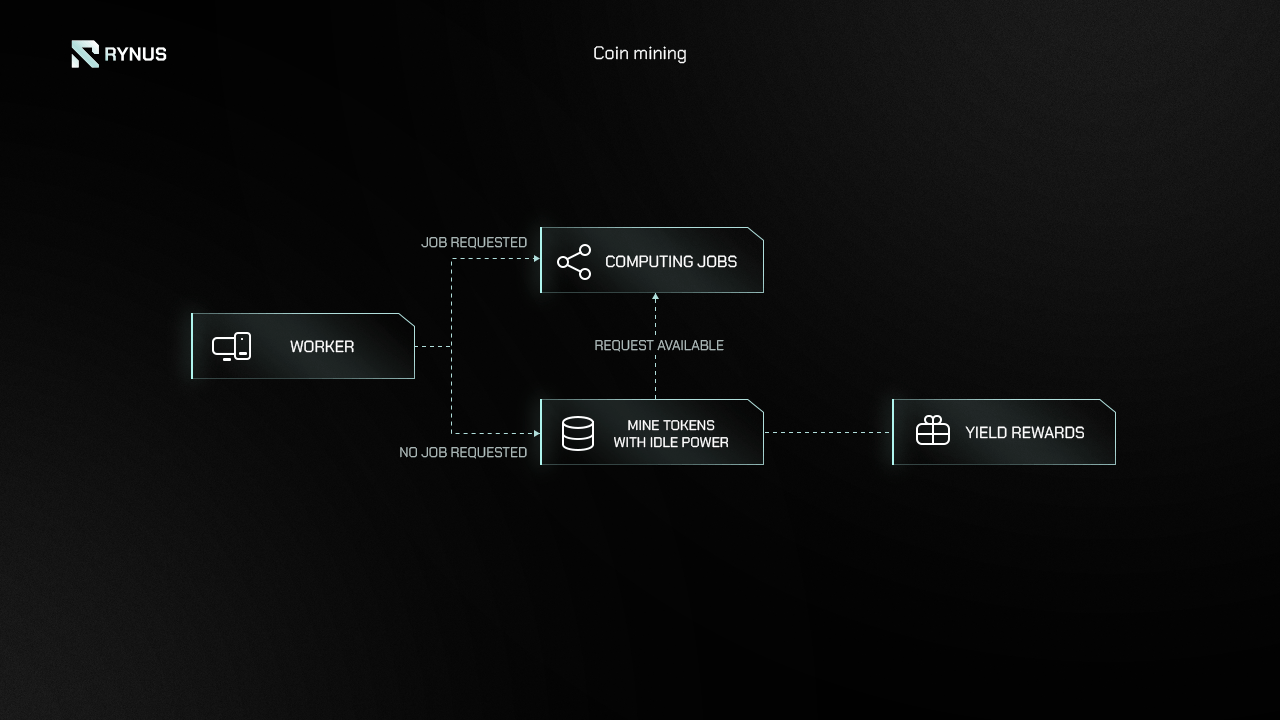
Coin Mining Integration: One-click deployment to yield extra rewards
Decentralized Pricing Controls
Unlike other cloud computing services where the platform or service provider sets the prices, Rynus allows GPU/CPU providers (Workers) to determine the cost of their hardware. Workers bid for computing jobs based on real-time supply and demand dynamics within the cloud computing market.
This unique approach results in a fluctuating cost structure that reflects current market conditions, ensuring a more equitable and transparent pricing model. By giving Workers control over their pricing, Rynus fosters a decentralized ecosystem driven by market forces. This system not only democratizes the cloud computing market but also aligns with the principles of decentralization and user empowerment, offering greater freedom and fairness to all participants.
Superior Transaction Speed
Transactions per second (TPS) refers to the maximum number of transactions that can be processed by a computer system within a certain amount of time. In the context of blockchains, TPS refers to the number of transactions that a network is capable of processing each second. Bitcoin TPS is 7 transactions per second, Ethereum 1.0 TPS is 30 transactions per second, and Solana TPS is 65,000 transactions per second.
Solana has proven to be the fastest among large blockchains, with a theoretical maximum speed of 65,000 TPS. Rynus leverages Solana for its exceptional transaction processing speed, ensuring swift and efficient handling of transactions on our network.